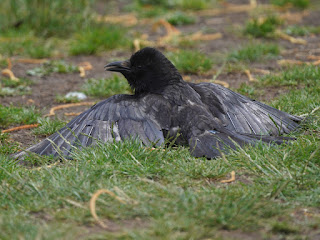The Round Pond was busy with Sand Martins and Swifts flying low over the water.
There were also House Martins, but I didn't get a picture of one.
It was a warm and mildly sunny morning, and a Carrion Crow was basking by the leaf yard.
The Little owlet at the Serpentine Gallery disliked being photographed and jumped around in the chestnut tree, making it impossible to get a good picture.
The adult female at the Round Pond is used to it, and looked out calmly from the horse chestnut branch where all the family like to perch.
Later it started to rain, and the male Peregrine on the tower was looking huddled and cross.
The young Grey Heron that hangs around the Henry Moore sculpture had been chased into a dead tree ...
... by the old boss, who was standing his ground below.
The pigeon-eating Lesser Black-Backed Gull had breakfasted and left, leaving the scanty remains for a Herring Gull to pick at.
The seven Coot chicks in the Italian Garden appeared all together in the frame for once.
The four chicks of the other family were improving their diving skills by the water lilies.
The four Mallard ducklings that miraculously survived the attentions of the Herring Gulls now look more or less like adult females. They are still staying together in a family group.
The four little ones by the Triangle car park have survived another day, but they have a long way to go.
The single Mute cygnet on the Round Pond was sitting beside its father on the gravel strip.
The following pictures were taken in the patch of thistles on the path at the foot of Buck Hill where I shot two videos yesterday. This, I think, is a female Thick-Legged Flower Beetle, Oedemera nobilis -- only the males have the bulgy legs that give them their name.
Her enjoyment of the thistle was disturbed by a Common Carder bee ...
... followed by another ...
... and finally a smaller bee that might be a Yellow-Legged Mining Bee, Andrena flavipes, but it was so slathered with yellow pollen that it's hard to tell what colour its legs are. Update: Conehead 54 thinks not -- see comment below.
















Yet again another awesome spot, the Sand Martin! Well done!
ReplyDeleteTheodore
Usually it's almost all House Martins and Swifts, but there were plenty of Sand Martins today. We get the occasional Swallow but never many.
DeleteI adore Sand Martins. The word 'cute' was invented for them.
ReplyDeleteIt's not being a good year for swans, isn't it. I think there are fewer cygnets than I expected.
Tinúviel
I'm just as fond of House Martins and their ingenious nests laboriously made of mud and spit.
DeleteNo, it's been a bad year for swans, thanks to pike and the old horror on the Serpentine.
Nice to see the Sand Martins. Perhaps these are birds that have breeding? Some have been reported leaving places such as Portland.
ReplyDeleteI don't think the last bee can be an Andrena sp as it appears to have a scopa (pollen brush) beneath the abdomen. I wonder if it might be a Heriades (I'm far from certain)?
Thanks. None of the other pictures of this brief visitor shows any more detail.
DeleteHave never seen sand martins anywhere in London before - what a welcome sight!
ReplyDeleteA certain lack of sandbanks in city centres, I suppose. But wherever they're nesting, the insect-rich air above the park is an attraction.
Delete